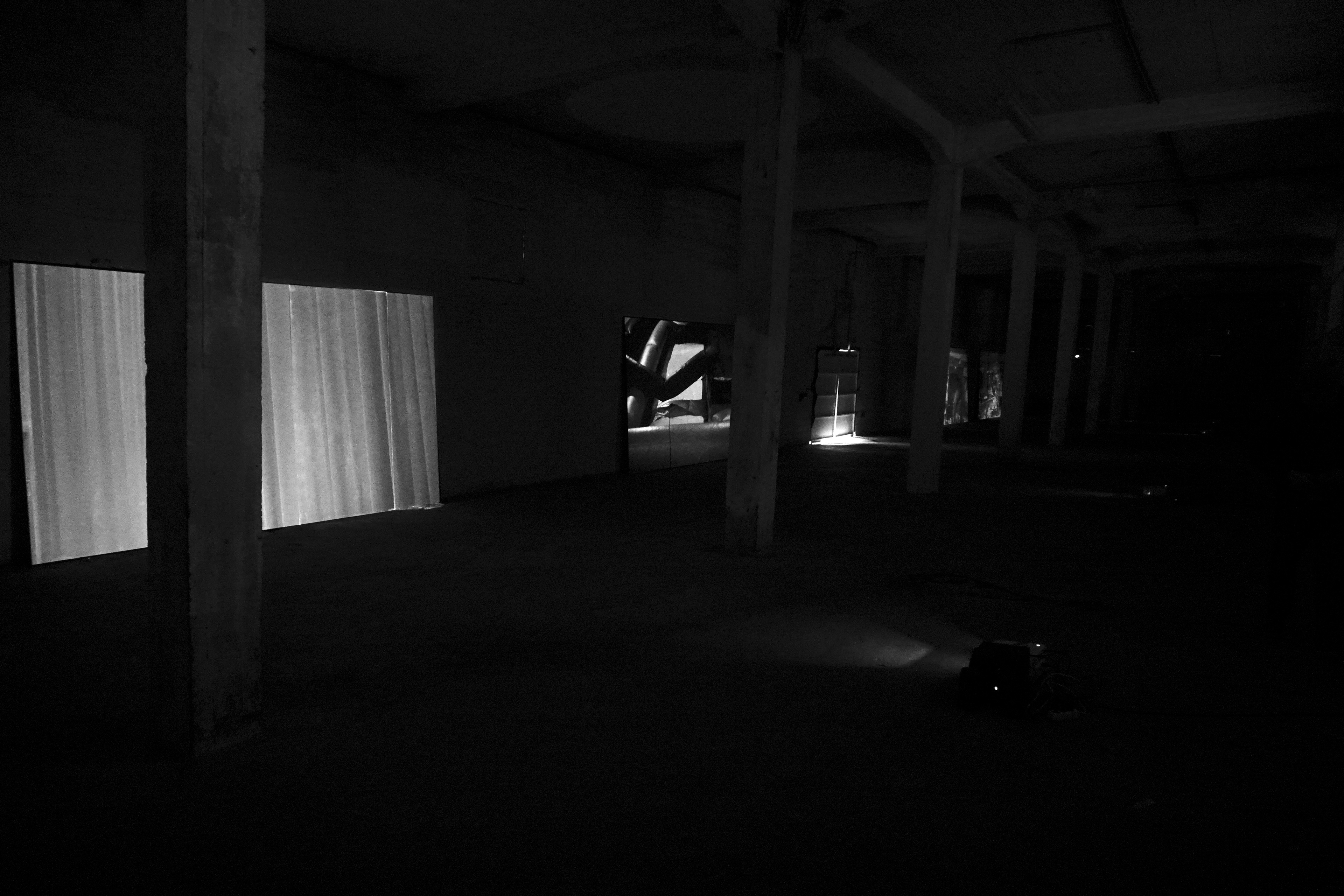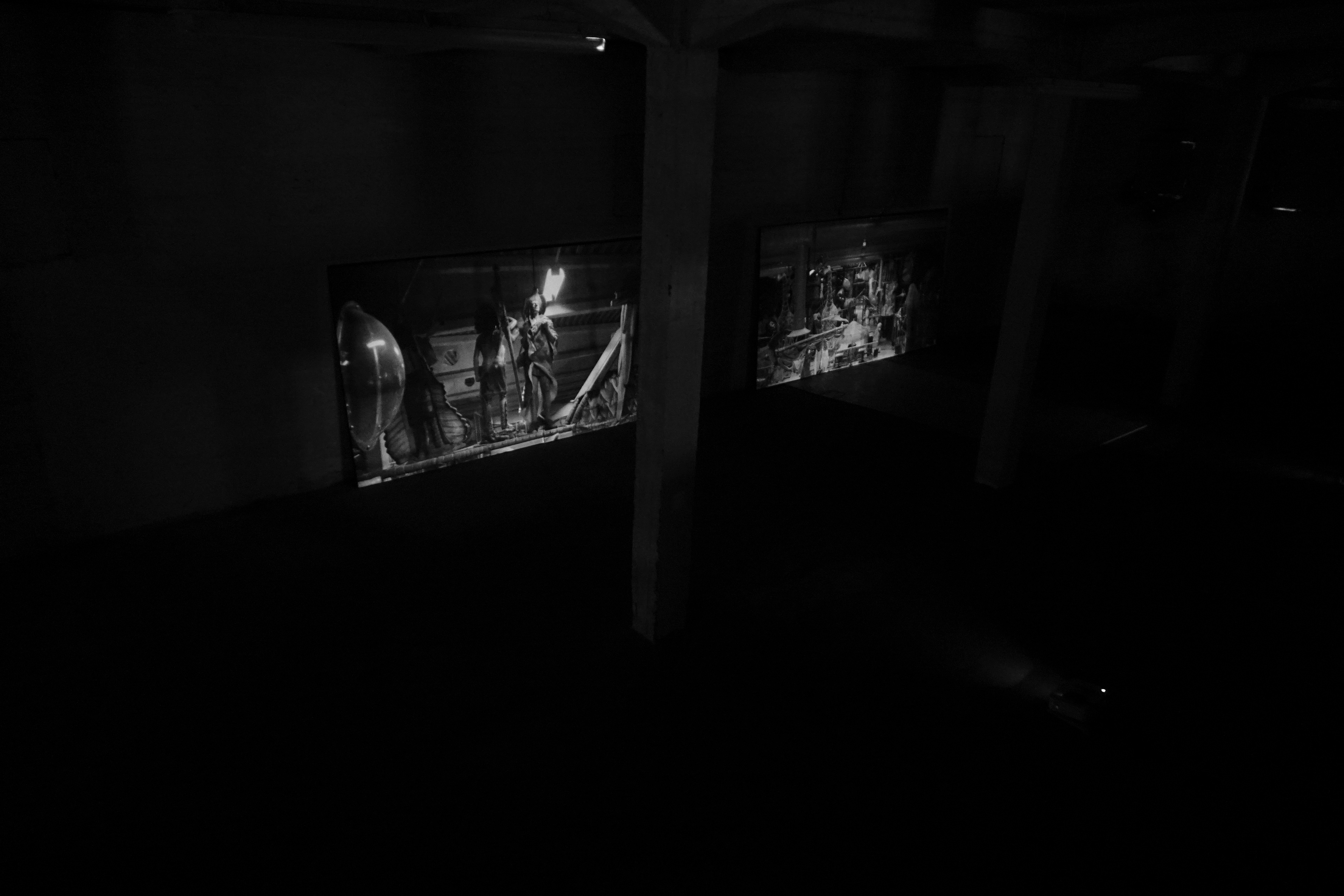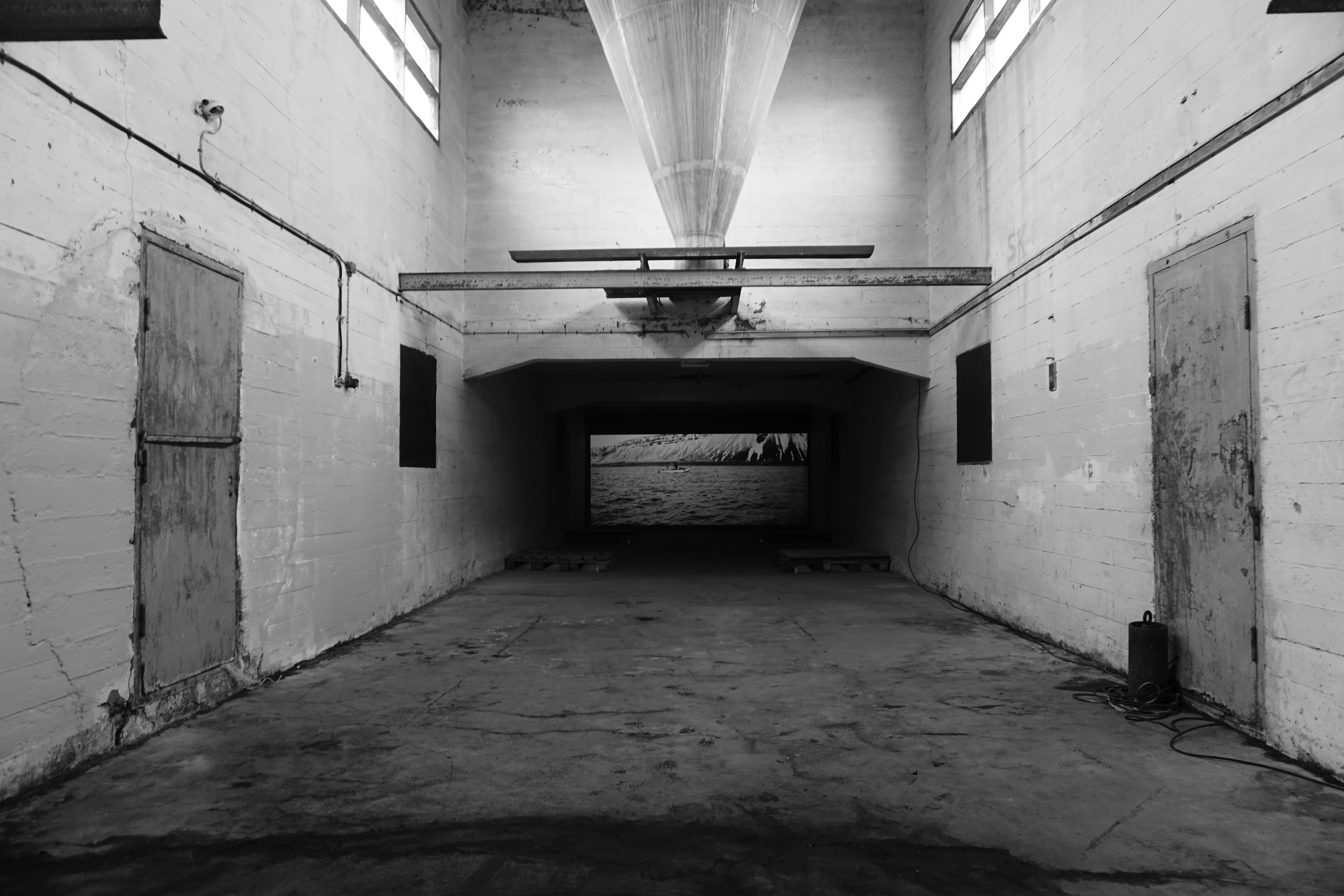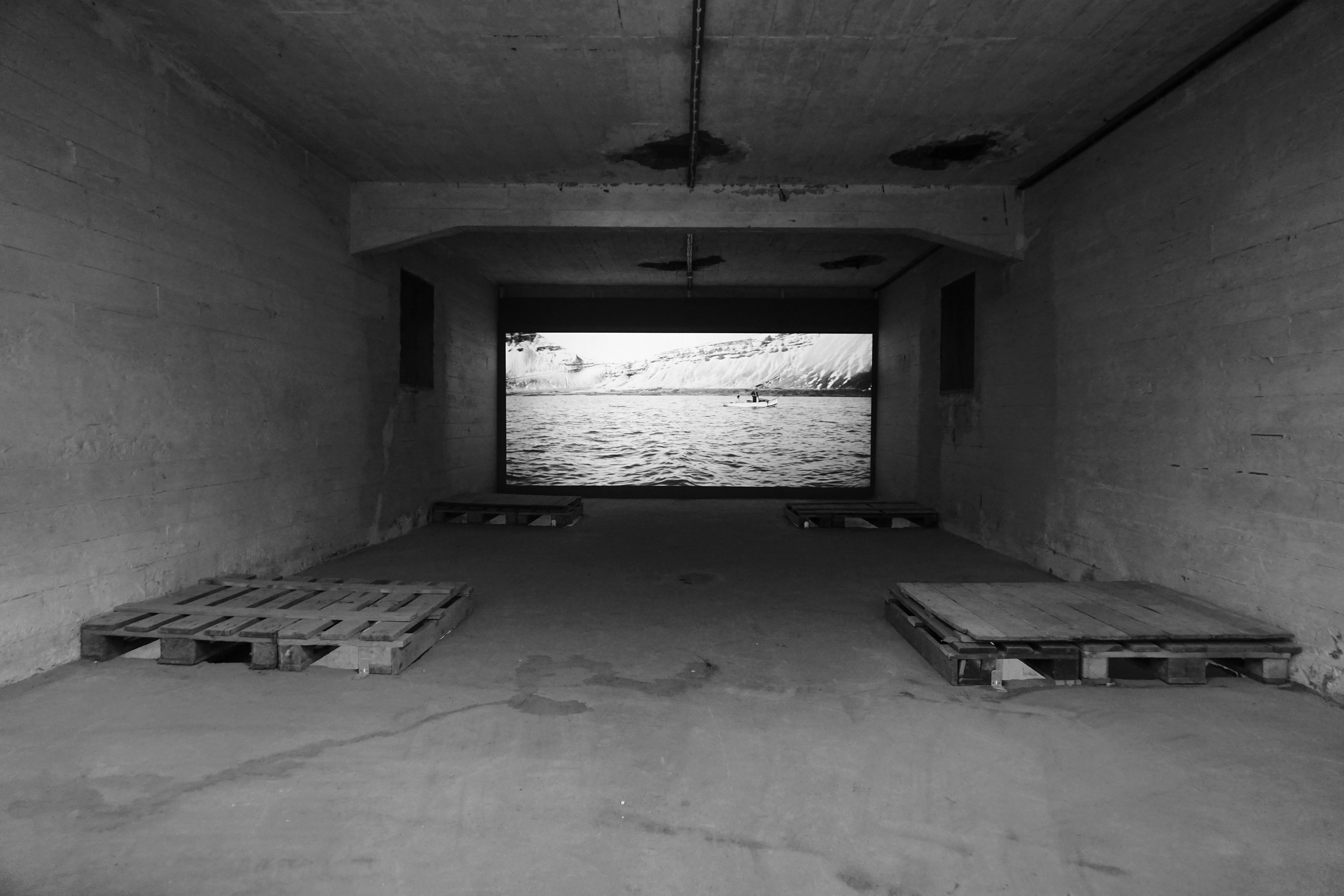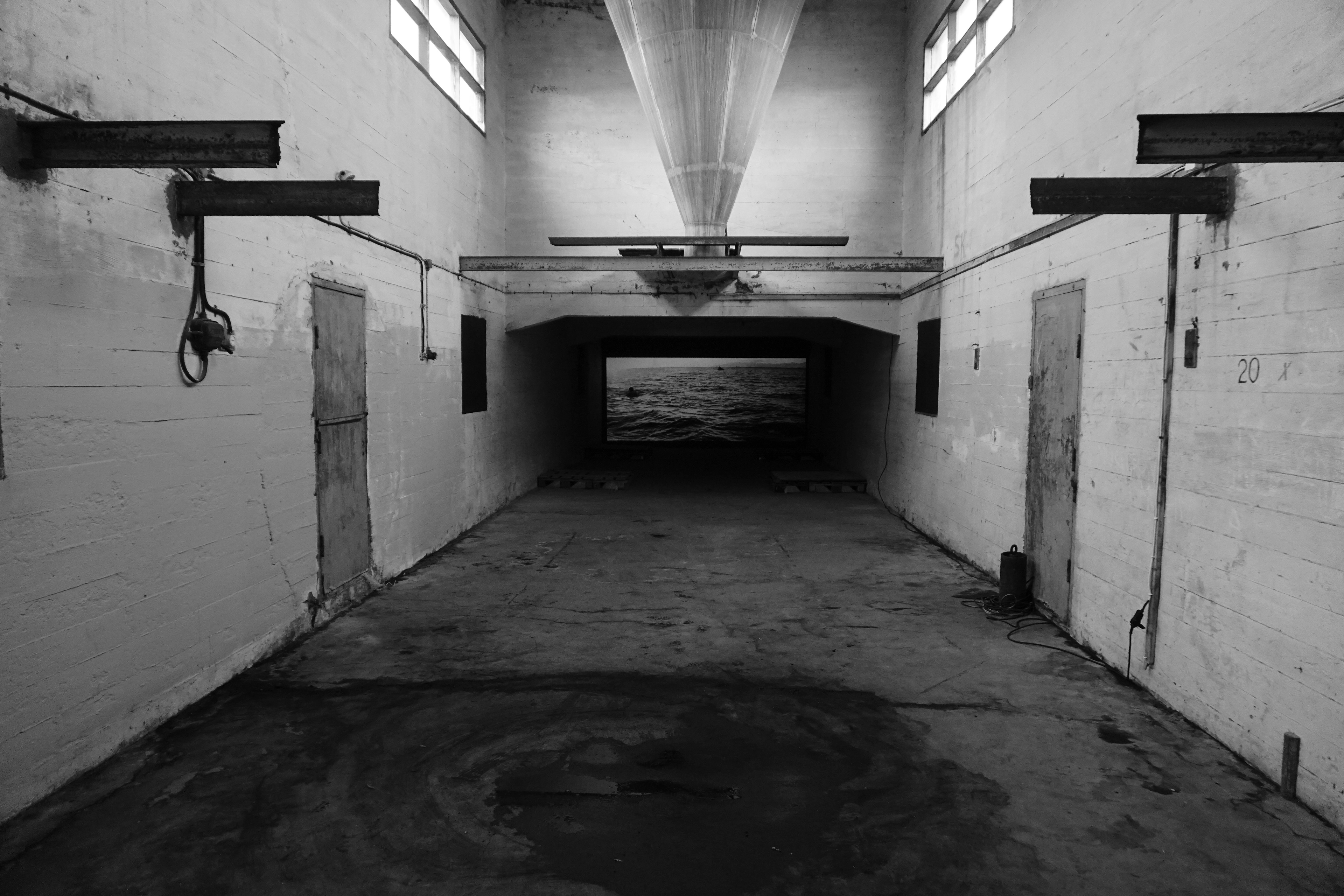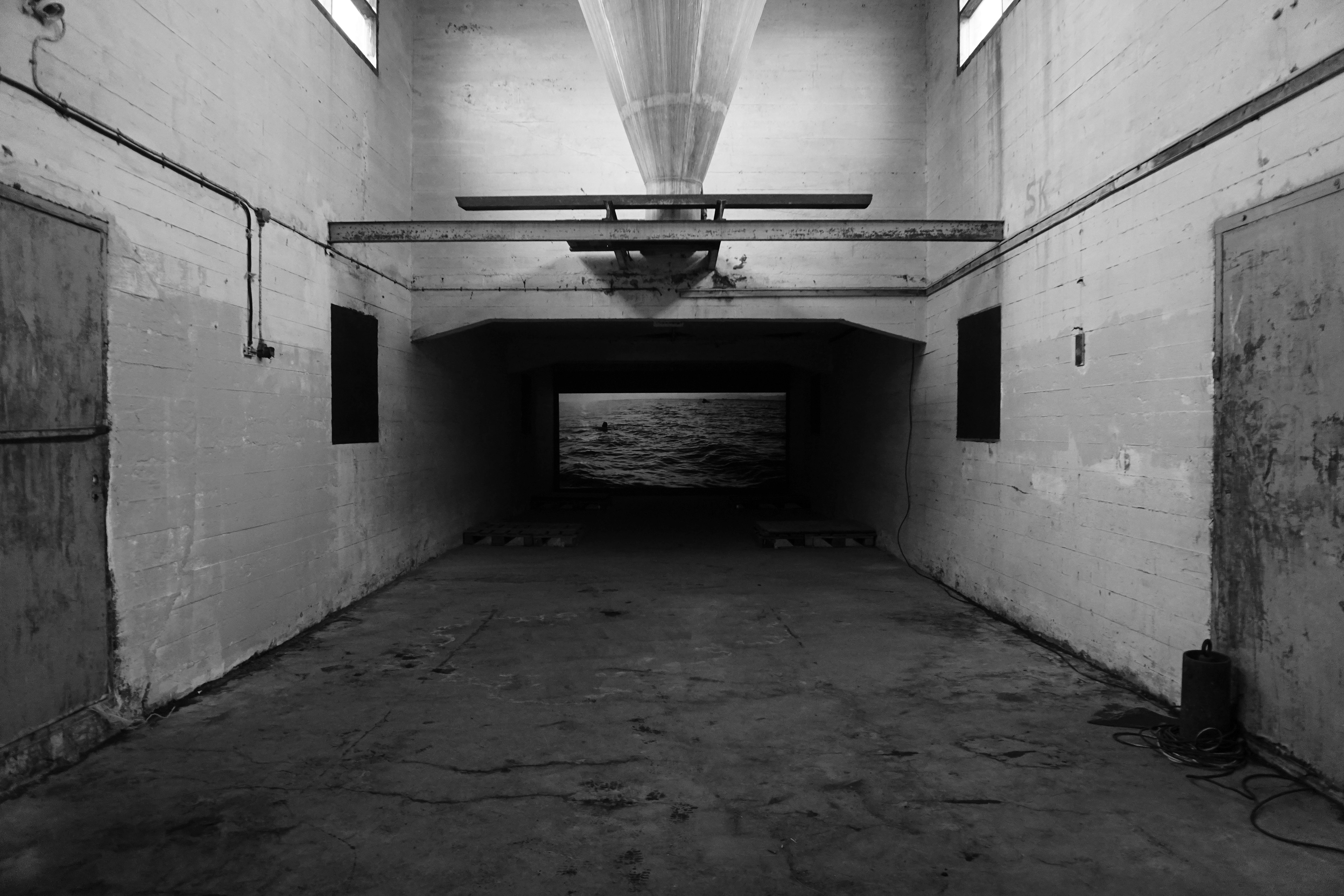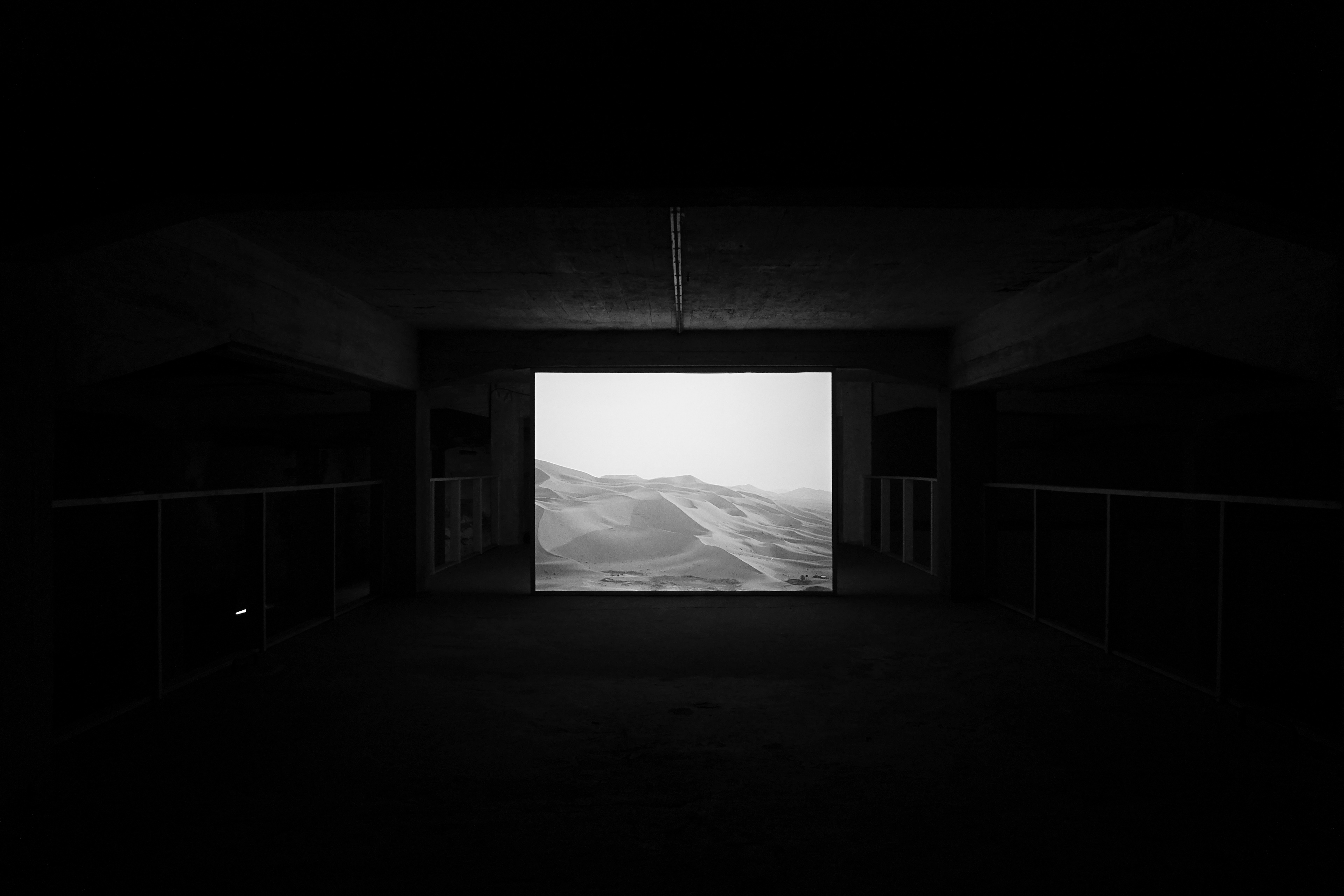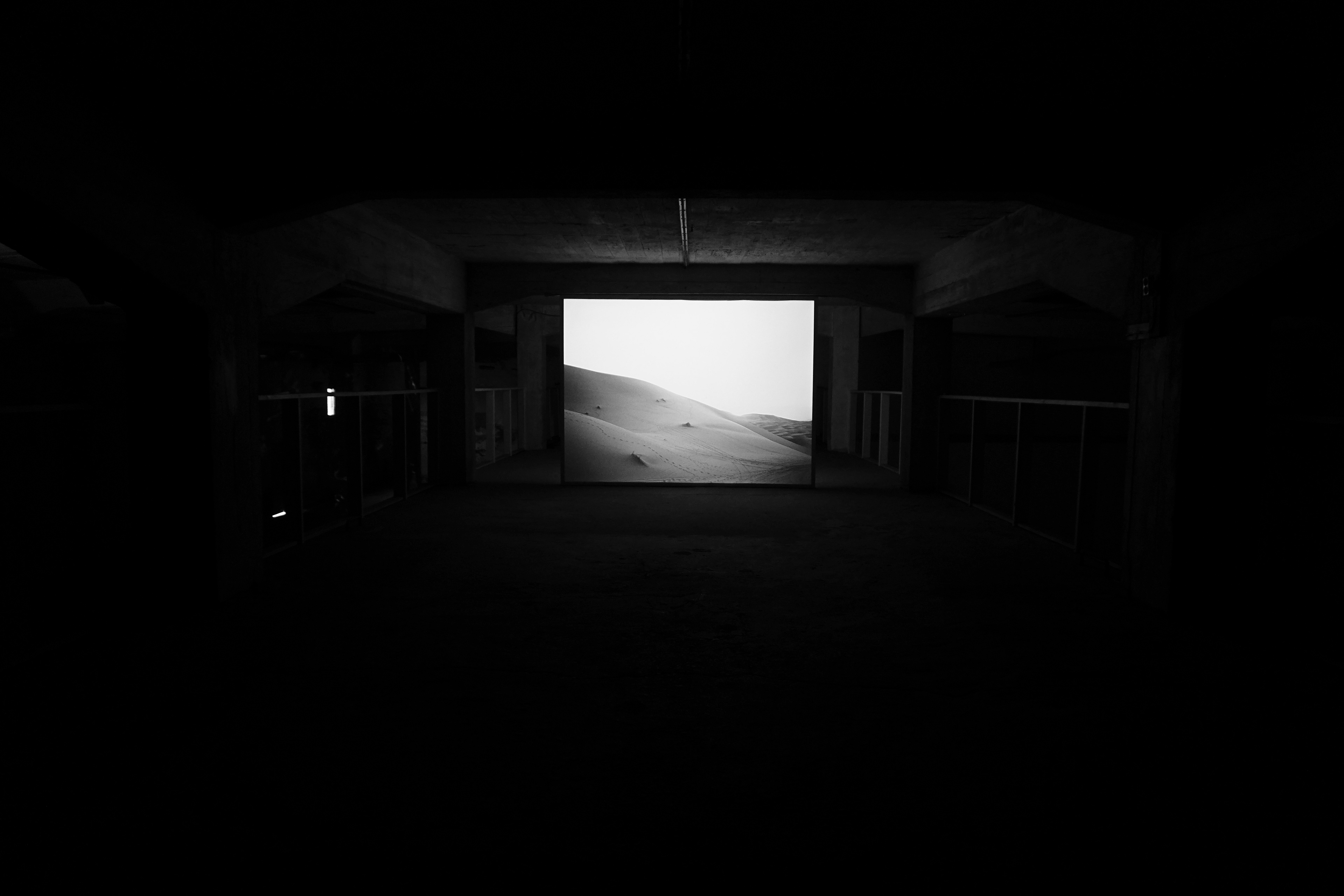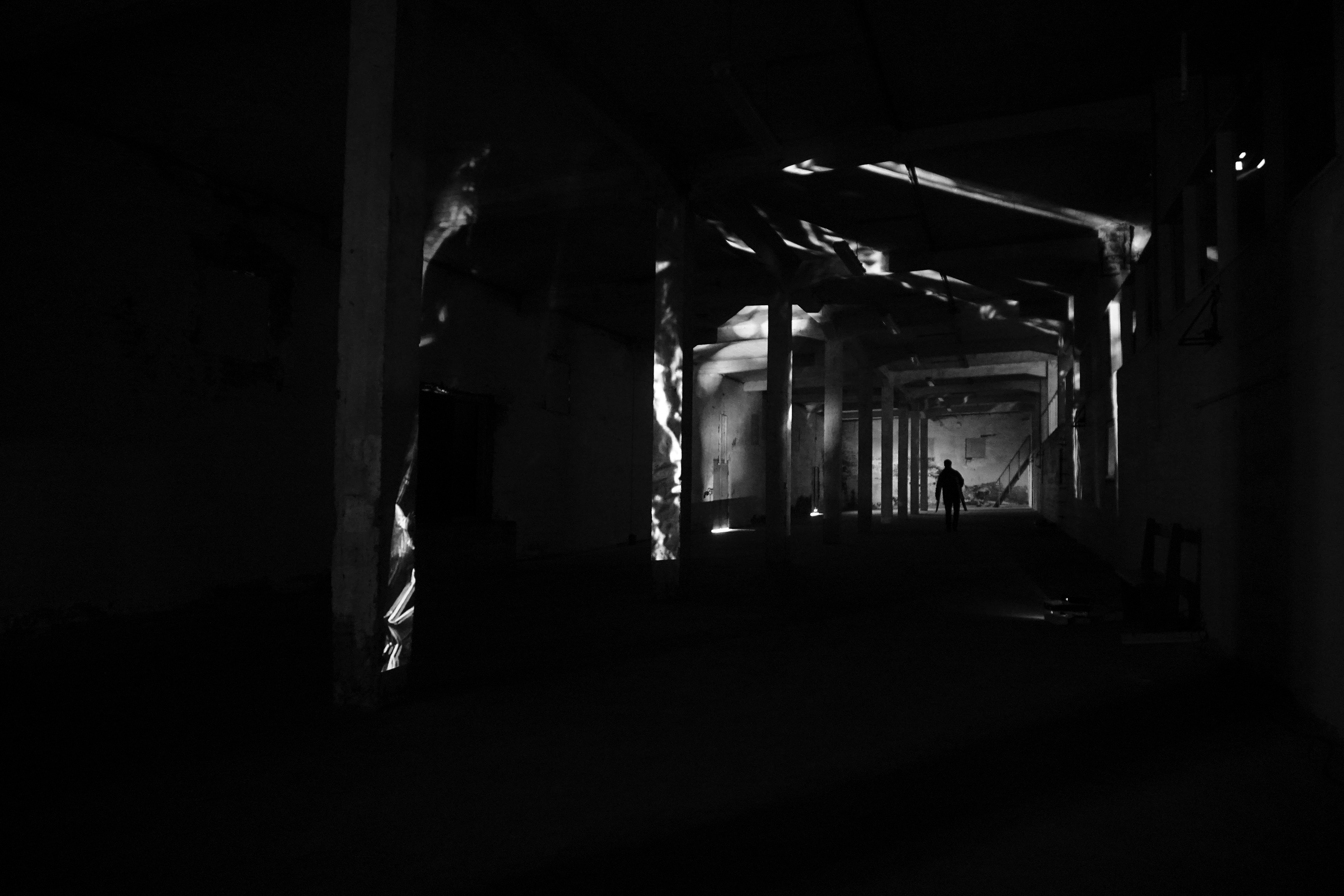03.11 / 25.11 2018 BROT ÚR LÍNU
Artists/ Listamenn:
Þorgerður Þóhallsdóttir
Þorbjörg Jónsdóttir
Bjarni þór Pétursson
Hlynur Pálmason
Curators / Sýningarstjórar: Sigurður Guðjónsson, Gústav Geir Bollason
Text / Höfundur texta: Jóhannes Dagsson. (see below)
Sýningin er styrkt af afmælisnefnd aldarafmælis fullveldis Íslands og hluti af opinberri dagskrá afmælisársins.
Fragment of a Line opens in November at Verksmiðjan. The four emerging artists taking part; Þorgerður Þórhallsdóttir, Bjarni Þór Pétursson, Hlynur Pálmason and Þorbjörg Jónsdóttir, all take up residency at the intersection of film and video in their works. They work with influences and solutions from these different mediums in works characterized by a strong sense of narration, personal aesthetics, and playful engagement with the properties of the medium. The exhibition space is integrated into the works, the factory re-vitalised, through light, sound and the conglomeration of the inner space of the works and the actual space of the exhibition.
The frames of the film have become the symbol for movement that can be perceived and understood. Events and processes broken down into units, and then re-assembled with the turning on of a film projector. This symbol is intertwined with ideas (and symbols) of cause and effect, a coherent continuation of the content of one frame following another. We look for explanations of the visual content of each frame, by referring to the previous one, and so ad infinitum. This interchanging of two explanatory systems is strengthened even further by the material properties of the film. It is cut and pasted together, but only if the pasting holds, does the image continue to appear. We are infatuated by the murmur of the wheel, not only because of the nostalgic image, but also because we perceive and understand what kind of a causal chain is at work. In the medium of video the perception of this chain is much more difficult and even impossible. What happens digitally happens in the realm of codes, as hidden, happens somewhere behind the visible. It only shows as an offspring, not as an outcome of a coherent process to be perceived and understood.
Time is only change. As long as nothing changes, no time has passed. Image after image, the after is the continuation. Narration or a story is probably the form that we most commonly look though at this phenomenon. One thing leads to another in the story and that is how time also passes. Movement is only change. Material object moves from one place to another, a finger presses a light switch, the light comes on, the living room becomes manageable. Purpose or intention are probably the forms we most commonly look at this phenomenon through. Movement can be either an action (explained by the intention of the one performing the action) or an occurrence (explained by laws of physics, or by chance). To perceive is therefore always also to understand. We perceive through a form, and only by doing so do we see time, change, continuation, action, event.
Light is the material in this Fragment of a line. Light, not only as the medium that carries the image to the surface, but as material in the same way as references, memories, ideas, and hard discs are materials. The raw space of the factory is a container for this material, and a good one at that, further strengthened by the November darkness. The inner space of the works becomes bodily and the light material. This is a mixing of references to the past, being lost in the desert, and a child’s game, into a sensual experience that is layered and complicated, but at the same time it brings forward important questions, and as usual these are of the simple kind.
The frames of the film have become the symbol for movement that can be perceived and understood. Events and processes broken down into units, and then re-assembled with the turning on of a film projector. This symbol is intertwined with ideas (and symbols) of cause and effect, a coherent continuation of the content of one frame following another. We look for explanations of the visual content of each frame, by referring to the previous one, and so ad infinitum. This interchanging of two explanatory systems is strengthened even further by the material properties of the film. It is cut and pasted together, but only if the pasting holds, does the image continue to appear. We are infatuated by the murmur of the wheel, not only because of the nostalgic image, but also because we perceive and understand what kind of a causal chain is at work. In the medium of video the perception of this chain is much more difficult and even impossible. What happens digitally happens in the realm of codes, as hidden, happens somewhere behind the visible. It only shows as an offspring, not as an outcome of a coherent process to be perceived and understood.
Time is only change. As long as nothing changes, no time has passed. Image after image, the after is the continuation. Narration or a story is probably the form that we most commonly look though at this phenomenon. One thing leads to another in the story and that is how time also passes. Movement is only change. Material object moves from one place to another, a finger presses a light switch, the light comes on, the living room becomes manageable. Purpose or intention are probably the forms we most commonly look at this phenomenon through. Movement can be either an action (explained by the intention of the one performing the action) or an occurrence (explained by laws of physics, or by chance). To perceive is therefore always also to understand. We perceive through a form, and only by doing so do we see time, change, continuation, action, event.
Light is the material in this Fragment of a line. Light, not only as the medium that carries the image to the surface, but as material in the same way as references, memories, ideas, and hard discs are materials. The raw space of the factory is a container for this material, and a good one at that, further strengthened by the November darkness. The inner space of the works becomes bodily and the light material. This is a mixing of references to the past, being lost in the desert, and a child’s game, into a sensual experience that is layered and complicated, but at the same time it brings forward important questions, and as usual these are of the simple kind.
// Jóhannes Dagsson
Sýningin Brot úr línu opnar í Verksmiðjunni á Hjalteyri í Nóvember. Á sýningunni eru vídeóverk eftir fjóra unga listamenn; Þorgerði Þórhallsdóttir, Bjarna Þór Pétursson, Hlyn Pálmason og Þorbjörgu Jónsdóttir. Listamennirnir eiga það sammerkt að taka sér stöðu á mörkum kvikmyndarinnar og vídeó miðilsins í verkum sínum. Þau sækja áhrif og úrlausnir í báðar þessar greinar og úr verður nýr og spennandi frásagnarmáti, sem einkennist af sterkri fagurfræði, leik með tæknilegar eigindir miðilsins og með sýningarrýmið í framsetningu verkanna. Verksmiðjan aflvæðist á ný, með ljósi og hljóði og rými verkanna hverfist saman við rými sýningarstaðarins.
Rammar kvikmyndarinnar eru löngu orðnir táknmynd fyrir hreyfingu sem hægt er að skynja og skilja. Atvik og framrás hreyfinga brotin niður í eigindir sem svo er raðað saman aftur um leið og kveikt er á sýningarvélinni. Þessi táknmynd er um margt samofin hugmyndum um orsök og afleiðingu, að rökrétt framrás stýri eða hafi í það minnsta áhrif á það sem birtist í næsta ramma. Við leitum skýringar á myndrænu innihaldi rammans í rammanum á undan og þannig koll af kolli. Þess samsláttur tveggja skýringarkerfa styrkist enn með hliðsjón af efnislegum eiginleikum filmunnar. Hún er klippt niður og skeytt saman aftur, en aðeins með því að samskeytin haldi heldur myndin áfram að birtast. Við heillumst af niðnum í hjóli sýningarvélarinnar, ekki aðeins af því það er nostalgísk ímynd, heldur einnig af því að við skiljum hvaða orsakasamhengi er hér að verki. Innan vídeómiðilsins er þetta samband mun brothættara, og jafnvel ekki til staðar. Það sem gerist stafrænt er kóðað og dulið, gerist fyrir aftan hinn sýnilega heim, og birtist aðeins sem afsprengi sitt, ekki sem afleiðing sem hægt er að skynja og skilja í krafti orsakar.
Tími er aðeins breyting, á meðan ekkert breytist, líður enginn tími. Mynd eftir mynd, vísar til þessara framrásar. Narratíva eða saga (sögurþráður) er trúlega það form sem við erum vönust að horfa á þetta fyrirbæri í gegnum, eitt leiðir af öðru í framrás sögunnar og þannig líður tíminn um leið. Hreyfing er aðeins breyting. Efnislegur hlutur færist af einum stað til annarrs, fingur ýtir á rofa, ljós kviknar, það verður göngufært inní stofuna. Tilgangur, eða ætlan er trúlega það form sem við erum vönust að horfa á þetta fyrirbæri í gegnum. Hreyfing er þannig annaðhvort athöfn,(sem útskýrist af ætlan þess sem framkvæmir athöfnina) eða atvik (sem útskýrist af lögmálum eðlisfræðinnar, eða með vísun í hendingu). Það að skynja er þannig alltaf að skilja um leið, við horfum ekki án þess að horfa í gegnum ákveðið form og aðeins í gegnum það sjáum við, tíma, breytingu, framrás, athöfn.
Í Brot úr línu er ljós aðal hráefnið. Ljósið er ekki aðeins miðill fyrir myndina sem það ber á flötinn, heldur hráefni í sjálfu sér. Það er hráefni í sama skilningi og vísanir, minni, hugmyndir og harður diskur. Hrátt rými verksmiðjunnar er ílát fyrir þetta efni, það geymir það vel, sérstaklega svona innrammað í nóvembermyrkrið. Rými verkanna verður líkamlegt og birtan áþreifanleg. Hér renna saman vísanir í söguna, villur eyðimerkurinnar og leikur barnsins. Skynreynslu sem er marglaga og flókin, en vísar um leið í grunn spurningar, en slíkar spurningar eru yfirleitt einfaldar.
Rammar kvikmyndarinnar eru löngu orðnir táknmynd fyrir hreyfingu sem hægt er að skynja og skilja. Atvik og framrás hreyfinga brotin niður í eigindir sem svo er raðað saman aftur um leið og kveikt er á sýningarvélinni. Þessi táknmynd er um margt samofin hugmyndum um orsök og afleiðingu, að rökrétt framrás stýri eða hafi í það minnsta áhrif á það sem birtist í næsta ramma. Við leitum skýringar á myndrænu innihaldi rammans í rammanum á undan og þannig koll af kolli. Þess samsláttur tveggja skýringarkerfa styrkist enn með hliðsjón af efnislegum eiginleikum filmunnar. Hún er klippt niður og skeytt saman aftur, en aðeins með því að samskeytin haldi heldur myndin áfram að birtast. Við heillumst af niðnum í hjóli sýningarvélarinnar, ekki aðeins af því það er nostalgísk ímynd, heldur einnig af því að við skiljum hvaða orsakasamhengi er hér að verki. Innan vídeómiðilsins er þetta samband mun brothættara, og jafnvel ekki til staðar. Það sem gerist stafrænt er kóðað og dulið, gerist fyrir aftan hinn sýnilega heim, og birtist aðeins sem afsprengi sitt, ekki sem afleiðing sem hægt er að skynja og skilja í krafti orsakar.
Tími er aðeins breyting, á meðan ekkert breytist, líður enginn tími. Mynd eftir mynd, vísar til þessara framrásar. Narratíva eða saga (sögurþráður) er trúlega það form sem við erum vönust að horfa á þetta fyrirbæri í gegnum, eitt leiðir af öðru í framrás sögunnar og þannig líður tíminn um leið. Hreyfing er aðeins breyting. Efnislegur hlutur færist af einum stað til annarrs, fingur ýtir á rofa, ljós kviknar, það verður göngufært inní stofuna. Tilgangur, eða ætlan er trúlega það form sem við erum vönust að horfa á þetta fyrirbæri í gegnum. Hreyfing er þannig annaðhvort athöfn,(sem útskýrist af ætlan þess sem framkvæmir athöfnina) eða atvik (sem útskýrist af lögmálum eðlisfræðinnar, eða með vísun í hendingu). Það að skynja er þannig alltaf að skilja um leið, við horfum ekki án þess að horfa í gegnum ákveðið form og aðeins í gegnum það sjáum við, tíma, breytingu, framrás, athöfn.
Í Brot úr línu er ljós aðal hráefnið. Ljósið er ekki aðeins miðill fyrir myndina sem það ber á flötinn, heldur hráefni í sjálfu sér. Það er hráefni í sama skilningi og vísanir, minni, hugmyndir og harður diskur. Hrátt rými verksmiðjunnar er ílát fyrir þetta efni, það geymir það vel, sérstaklega svona innrammað í nóvembermyrkrið. Rými verkanna verður líkamlegt og birtan áþreifanleg. Hér renna saman vísanir í söguna, villur eyðimerkurinnar og leikur barnsins. Skynreynslu sem er marglaga og flókin, en vísar um leið í grunn spurningar, en slíkar spurningar eru yfirleitt einfaldar.







